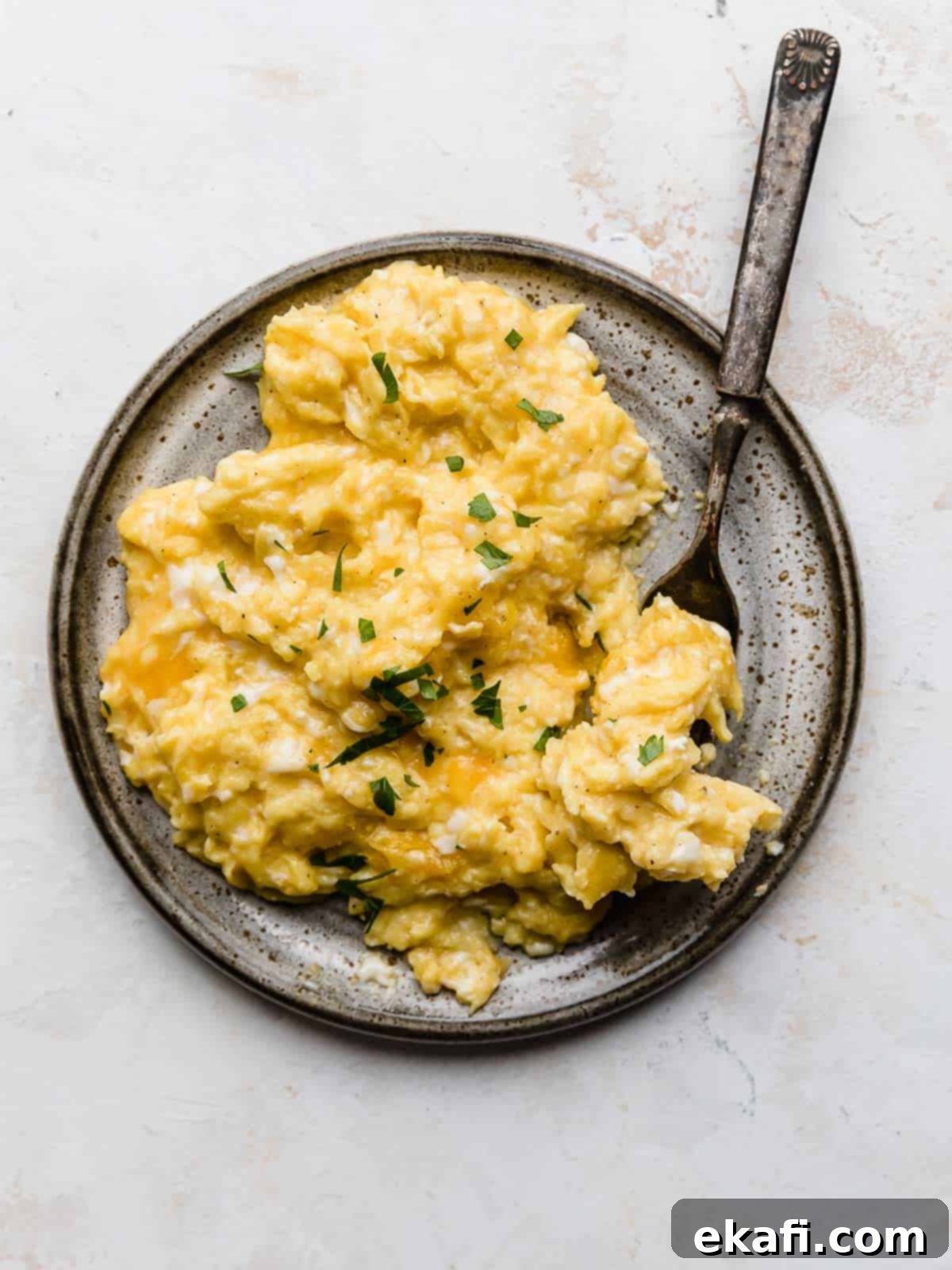The Ultimate Guide to Perfectly Fluffy & Cheesy Scrambled Eggs
There’s nothing quite like a plate of perfectly cooked, fluffy, and incredibly cheesy scrambled eggs to kickstart your day. This recipe isn’t just about mixing eggs and cheese; it’s about achieving egg perfection. We’re talking about soft, delicate egg folds, infused with rich butter and savory cheese, that are neither tight and dry nor watery and bland. These aren’t your average hurried morning eggs; these are the kind of scrambled eggs that make you truly savor breakfast, providing a comforting and satisfying start to any day.
Beyond these sensational cheesy scrambled eggs, I adore exploring various delicious egg breakfasts. My avocado egg toast recipe offers a fresh and healthy twist, while my easy breakfast casserole is perfect for feeding a crowd. Breakfast holds a special place in my heart – whether it’s classic pancakes, hearty oatmeal, or crispy bacon, there’s an undeniable warmth and deliciousness that comes from a hot, homemade morning meal. This cheesy scrambled egg recipe promises to deliver that same comforting experience, every single time.
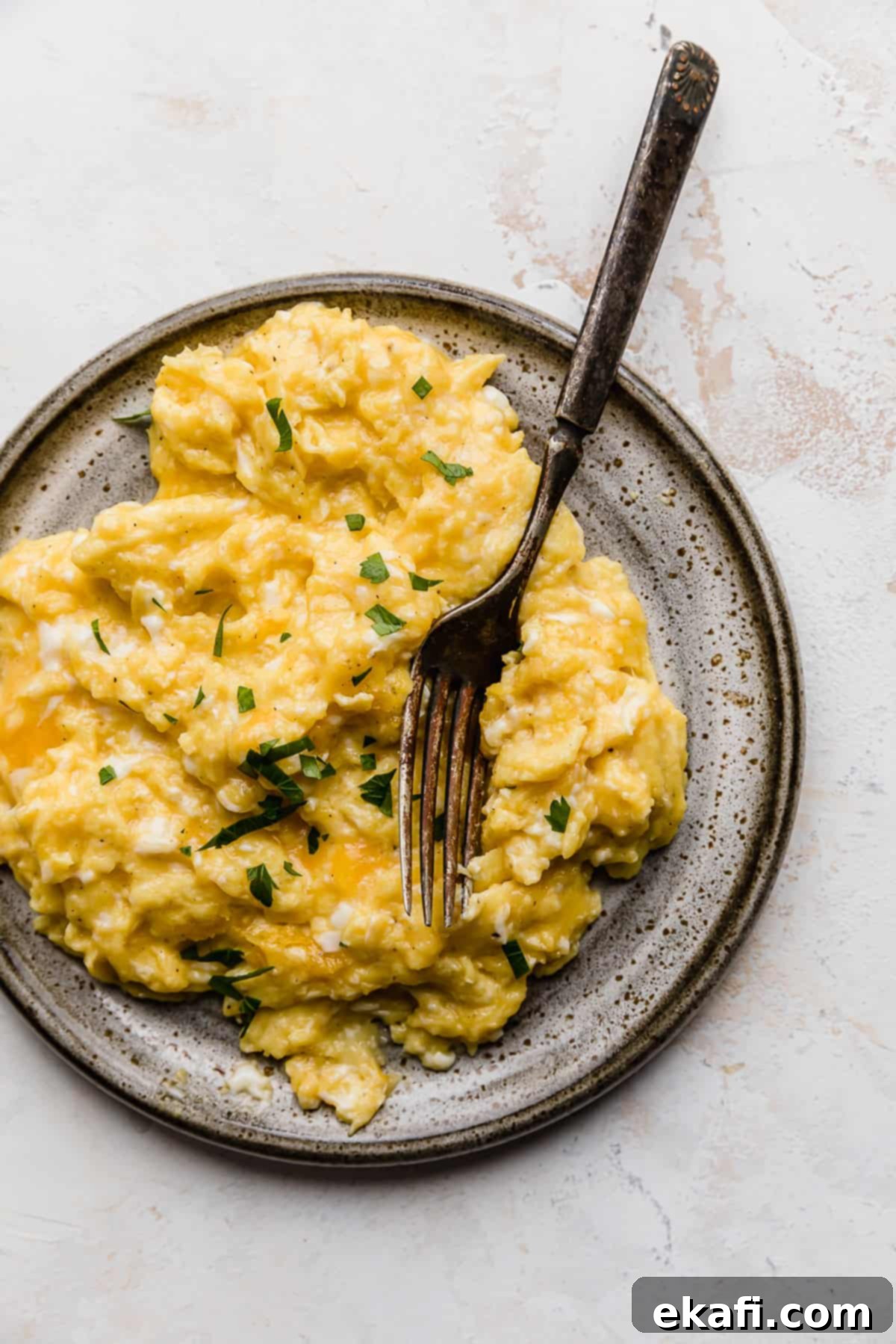
Why This Cheesy Scrambled Eggs Recipe is a Game-Changer
Forget everything you thought you knew about scrambled eggs. This recipe consistently delivers on its promise of perfect eggs, thanks to a few key principles:
- Unbelievably Moist, Soft, and Fluffy Scrambled Eggs. The days of rubbery, dry, or overcooked scrambled eggs are over! My method focuses on gentle cooking and consistent stirring, creating delicate, moist folds that practically melt in your mouth. We avoid high heat and excessive liquid additions, which often lead to less-than-ideal textures. The result is a light, airy scramble that maintains its moisture without being watery.
- Irresistibly Delicious Cheesy Flavor. The star of the show, beyond the eggs themselves, is the fantastic cheesy flavor. We’re not just adding cheese for the sake of it; we’re integrating it in a way that allows its rich, savory notes to truly shine and complement the eggs beautifully. This harmonious blend of egg and cheese is, in my opinion, one of the best breakfast combinations imaginable, and it’s why these eggs will become a fast favorite in your home.
- Quick, Easy, and Power-Packed with Protein. In today’s fast-paced world, a quick and easy breakfast is essential. This recipe comes together in just about 5 minutes, making it ideal for busy mornings. More importantly, it’s a powerhouse of protein. The eggs, combined with the cheese, provide a substantial amount of protein that will keep you feeling full and energized for longer, helping you avoid those mid-morning energy slumps. So, put away the sugary cereal and elevate your morning routine with these satisfying, protein-rich cheesy scrambled eggs!
Essential Ingredients for Perfect Cheesy Scrambled Eggs
While scrambled eggs seem simple, the quality and preparation of a few key ingredients make all the difference. Here’s a closer look at what you’ll need and why it matters:
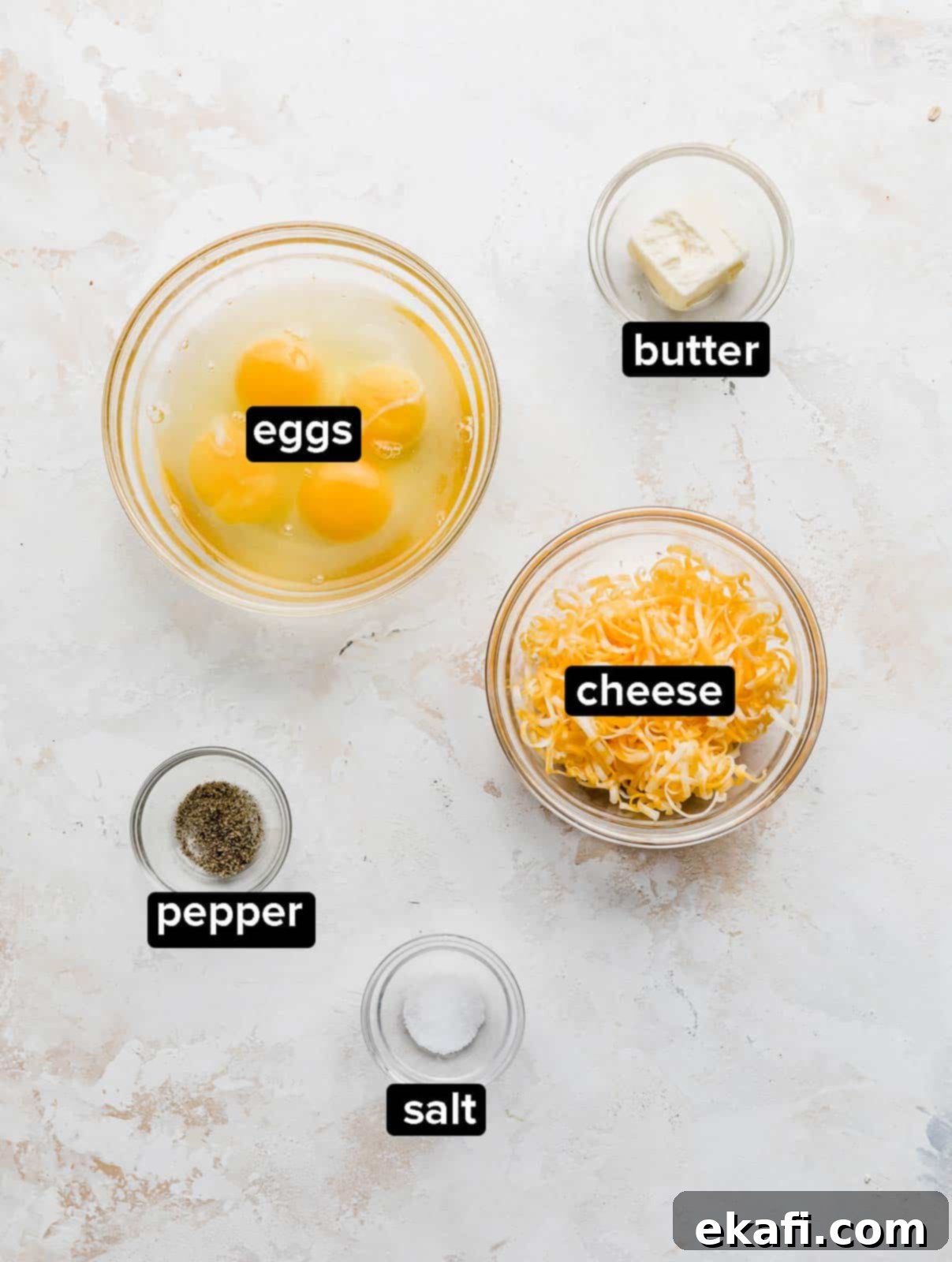
- Butter: Cooking your eggs in butter is a non-negotiable step for achieving unparalleled flavor and texture. Butter not only prevents sticking but also imparts a rich, nutty flavor that elevates the eggs far beyond what oil or cooking spray can do. Whether you choose salted or unsalted butter, make sure it’s a good quality brand for the best results. The fat in the butter is key to those tender, soft curds.
- Eggs: Naturally, the foundation of this dish. I typically use large eggs, as they’re standard for most recipes. While some recipes suggest adding milk or water, we’ll discuss why this recipe opts for pure egg goodness to avoid watery results. The key to fluffy eggs lies in the whisking technique, not in diluting the mixture.
- Cheese: Here’s where you can truly customize! The beauty of cheesy scrambled eggs is their versatility with different cheeses. While cheddar is a classic for its sharp flavor and excellent melting properties, don’t hesitate to experiment. Colby Jack offers a milder, creamier melt, Monterey Jack is superbly smooth, and for a bit of a kick, pepper jack is fantastic. For a gourmet touch, consider goat cheese for tanginess or feta for a salty bite. The most important tip for any cheese, however, is to *grate your own*. Pre-shredded cheeses often contain anti-caking agents that prevent them from melting smoothly, leading to a grainy texture instead of creamy deliciousness.
- Salt & Pepper: Simple but essential. These seasonings bring out the natural flavor of the eggs and cheese. Adjust to your personal preference; a little extra black pepper can add a nice aromatic kick, and don’t be afraid to finish with a pinch more salt after cooking for ultimate flavor.
How to Make the Best Cheesy Scrambled Eggs
Follow these simple steps to achieve fluffy, flavorful, and perfectly cheesy scrambled eggs every time:
- Prepare the Egg Mixture: In a medium-sized bowl, crack your eggs. Add the salt and pepper. Now, here’s a crucial step for fluffiness: whisk vigorously until the yolks and whites are completely combined and slightly frothy. This incorporates air, which is essential for creating those soft, airy curds.
- Melt the Butter: Place a nonstick skillet over medium-low heat. It’s important to start with a lower heat to prevent the eggs from cooking too quickly and becoming tough. Add the butter to the warmed pan. Once the butter is completely melted and slightly shimmering (but not browned), swirl it around to thoroughly coat the bottom and sides of the skillet. This creates a non-stick surface and infuses the eggs with rich flavor. Immediately pour the whisked egg mixture into the pan.
- Gentle Scramble: Using a silicone spatula (to protect your nonstick pan), immediately begin stirring the eggs. The key here is to stir slowly and constantly, drawing the cooked egg from the edges towards the center, creating soft folds or curds. Don’t aggressively break up the eggs. Continue this gentle folding for about 2 minutes. You’ll see the eggs begin to set into beautiful, creamy curds.
- Add the Cheese: After 2 minutes, sprinkle the freshly grated cheese evenly over the eggs. Continue to gently stir and fold for another minute. The residual heat will melt the cheese into a luscious, gooey coating, integrating its flavor throughout the eggs.
- Remove from Heat and Serve: As soon as the cheese is melted and the eggs are still slightly wet but mostly set – remember, they will continue to cook a little even after they’re off the heat – remove the skillet from the burner. This prevents overcooking, which is the enemy of fluffy scrambled eggs. Serve them warm immediately, topped with additional salt and pepper, or a sprinkle of fresh herbs like chives or parsley, if desired. Enjoy your perfectly cheesy and tender scrambled eggs!
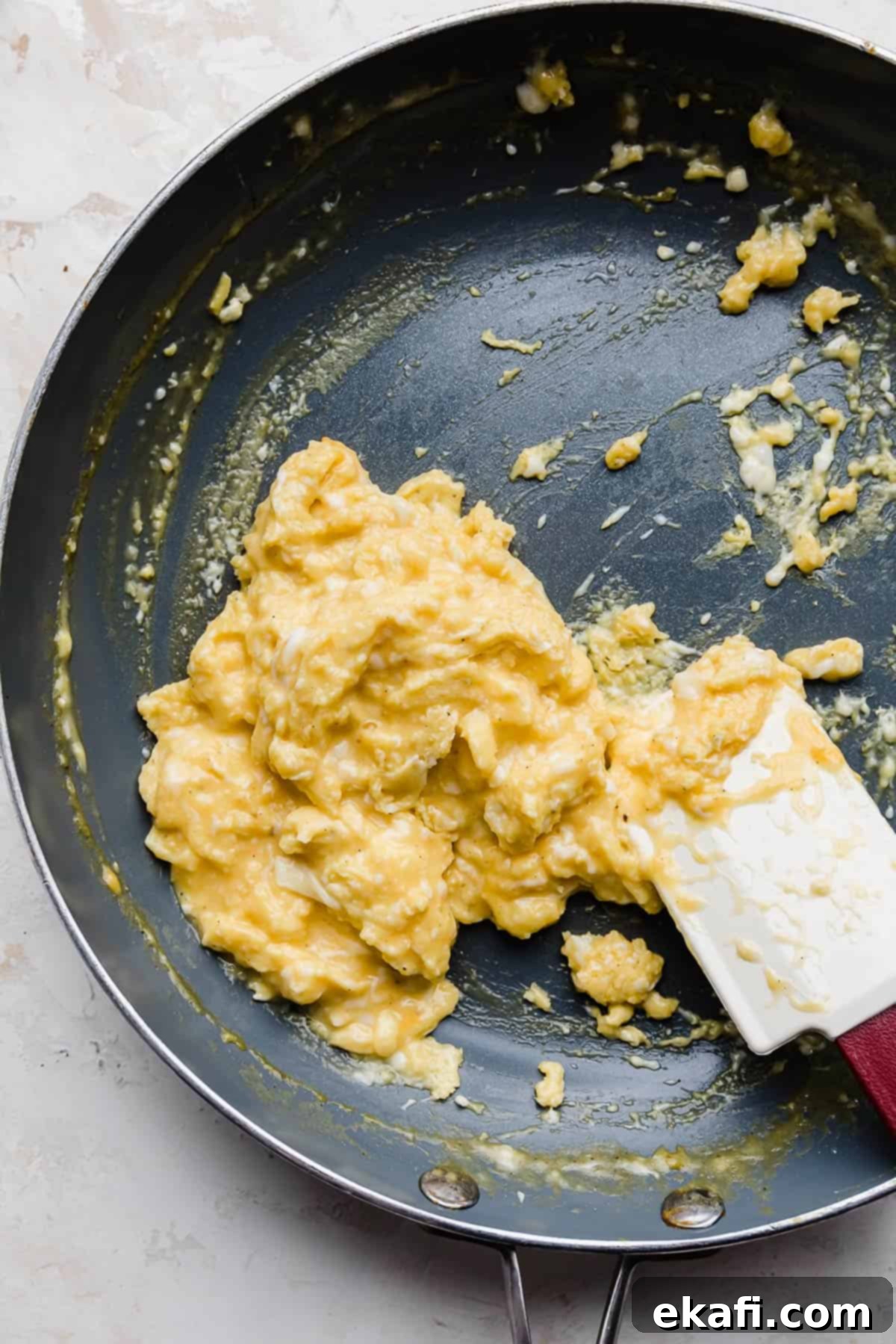
Expert Tips for the Best Cheesy Scrambled Eggs
Achieving truly perfect scrambled eggs isn’t just about following the steps; it’s about understanding the nuances. These tips will elevate your cheesy scrambled eggs from good to gourmet:
- Always Grate Your Own Cheese: This tip is worth repeating! Pre-shredded cheese from the store often contains cellulose or other anti-caking agents. While harmless, these agents prevent the cheese from melting smoothly, resulting in a slightly grainy or clumpy texture in your eggs. Freshly grated cheese, however, melts into a wonderfully creamy and seamless consistency, making your cheesy scrambled eggs truly luxurious.
- Proper Pan Preparation is Key: Ensure your nonstick pan is well-seasoned and adequately warmed before adding the butter. Starting with a cold pan or insufficient butter can lead to eggs sticking, even in a nonstick skillet. Once the pan is warm, add your butter and let it completely melt and shimmer. Swirling the melted butter around the pan ensures an even coating, creating a protective layer that prevents sticking and adds an amazing buttery flavor to every bite.
- Say No to Milk or Water (for this recipe): This might go against some traditional advice, but for this particular style of moist, soft, and fluffy scrambled eggs, we intentionally omit milk or water. Here’s why: adding any liquid increases the water content of the egg mixture. While it might seem like it makes the eggs “fluffier” initially, it often leads to a watery end product. To combat this excess moisture, you might be tempted to cook the eggs for longer, which inevitably results in tough, overcooked, and dry eggs. Our technique for achieving fluffiness relies on vigorous whisking to incorporate air, not on diluting the eggs. Trust the process; pure eggs cooked with butter and cheese yield the best texture.
- Don’t Overcrowd the Pan: If you’re making a larger batch for multiple servings, it’s better to cook the eggs in two separate batches rather than trying to fit too many into one pan. Overcrowding lowers the pan’s temperature and steams the eggs instead of gently scrambling them, leading to a less desirable texture.
- Cook Low and Slow: Patience is a virtue when it comes to scrambled eggs. Medium-low heat is your best friend. High heat will cook the eggs too quickly, making them tough and rubbery. Gentle, consistent heat allows the proteins to set slowly, creating those delicate, soft curds we’re aiming for.
- Know When to Stop: The eggs are done when they are mostly set but still appear slightly wet or glistening. Remember, they will continue to cook from residual heat after being removed from the pan (this is called carryover cooking). Pulling them off the heat a little early ensures they reach that perfect, creamy consistency rather than becoming dry.
Delicious Serving Suggestions for Cheesy Scrambled Eggs
These cheesy scrambled eggs are fantastic on their own, but they also pair wonderfully with a variety of sides to create a complete and satisfying meal:
- Serve as scrambled eggs on toast: A classic combination! A thick slice of toasted sourdough or artisanal bread makes a perfect base.
- With sautéed vegetables: Add some color and nutrition with quickly cooked spinach, mushrooms, bell peppers, or onions.
- With breakfast potatoes: Crispy hash browns or home fries are an excellent savory accompaniment.
- Inside breakfast burritos: Wrap them in a warm tortilla with salsa, avocado, and perhaps some beans or rice for a hearty meal on the go.
- With a side of oven-cooked bacon or sausage: For a traditional American breakfast feast.
- Alongside fresh fruit: A light and refreshing contrast to the richness of the eggs.
Frequently Asked Questions About Cheesy Scrambled Eggs
Here are answers to some of the most common questions about making perfect cheesy scrambled eggs:
The great news is that you truly can’t go wrong with cheese and scrambled eggs! Many varieties complement the flavor of eggs beautifully. Some popular and delicious choices include sharp cheddar, creamy Monterey Jack, a mild Colby Jack, or even a spicy pepper jack for a kick. For something different, consider a crumbly goat cheese or salty feta. The best cheese is ultimately a matter of personal preference, so feel free to experiment and find your favorite! Remember, always aim for freshly grated cheese for the best melt.
While many recipes call for it, I personally don’t add milk to my scrambled eggs, and here’s why: adding milk, or any liquid for that matter, increases the water content in the egg mixture. This can make the finished eggs overly watery or runny, and you might feel compelled to cook them for longer to evaporate that excess liquid, which leads to tough, dry, and overcooked eggs. For truly fluffy and soft scrambled eggs, the secret is vigorous whisking before they hit the pan. This incorporates air pockets into the mixture, resulting in light, airy, and moist scrambled eggs without the need for additional liquid.
The choice between milk, cream, or water depends entirely on the texture you desire, but it’s important to understand the trade-offs. If you prefer creamy scrambled eggs, a splash of milk or cream can achieve that. If fluffiness is your goal, some advocate for a bit of water, as it creates steam during cooking, which can lift the eggs. However, as mentioned previously, adding any additional liquid — be it milk, cream, or water — inevitably increases the overall moisture content of your egg mixture. This often results in a watery scramble and can lead to the common mistake of overcooking the eggs in an attempt to dry them out. For this recipe, we focus on whisking thoroughly to incorporate air, and cooking with butter on low heat, which naturally produces fluffy, moist, and delicious scrambled eggs without needing any extra liquid. This method ensures the eggs maintain their rich, pure flavor and ideal texture.
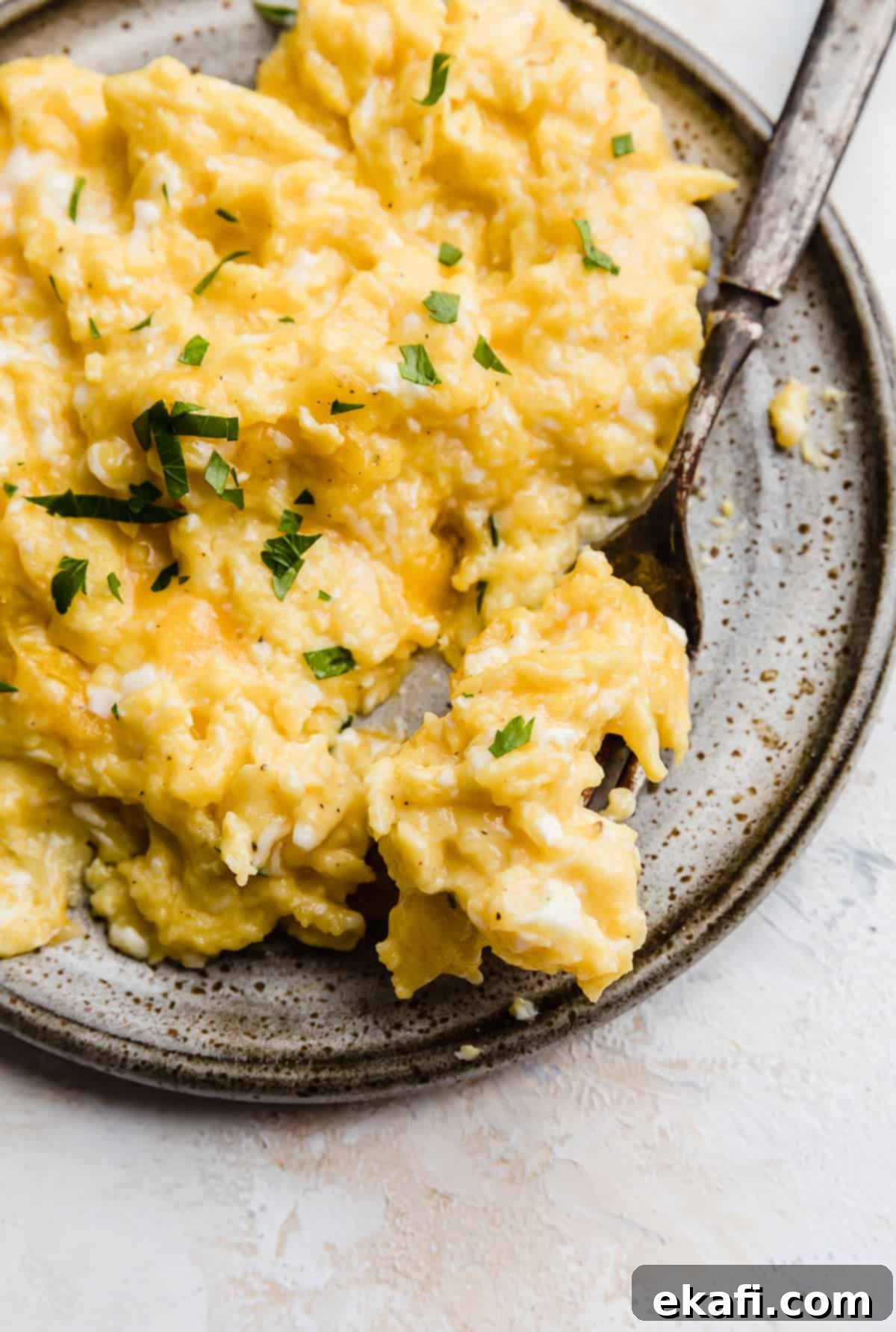
Explore More Delicious Breakfast Recipes
If you loved these cheesy scrambled eggs, you’ll surely enjoy exploring other breakfast favorites from our collection. Whether you’re in the mood for something hearty, healthy, or a sweet treat, we have a recipe for you:
- Hearty Steel Cut Oats: A warm and satisfying breakfast perfect for colder mornings.
- Healthy German Pancakes: A lighter take on a puffy, oven-baked classic.
- Banana Oatmeal Pancakes: A nutritious and delicious way to enjoy pancakes.
- Fluffy Almond Milk Pancakes: Dairy-free pancakes that don’t compromise on flavor or texture.
- Homemade Sausage Gravy: The ultimate comfort food to pair with fluffy biscuits.
Did you make this incredibly delicious cheesy scrambled eggs recipe? I’d absolutely love to hear about your experience! Click here to leave a rating and review, or simply scroll below the recipe card to share your thoughts. Your feedback helps other home cooks discover and enjoy these perfect eggs!
Stay up-to-date with all our latest recipes and kitchen tips by following us on Instagram, Facebook, and Pinterest. Don’t miss out on more culinary inspiration!
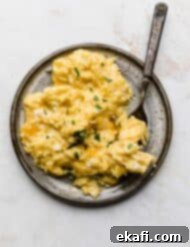
Print
SaveSaved!
Review
Cheesy Scrambled Eggs
Ingredients
- 1 tablespoon butter – salted or unsalted, for rich flavor and tenderness
- 4 eggs – (large eggs recommended for standard sizing)
- 1/4 teaspoon salt – adjust to your preferred taste
- pinch fresh ground pepper – add more or less to your liking
- 1/4 cup cheese – freshly grated is best! Choose from Cheddar, Colby Jack, pepper jack, goat cheese, feta, or any melty cheese you love.
Instructions
-
In a medium bowl, vigorously whisk the eggs, salt, and pepper together until completely well combined and slightly frothy. This incorporates air for fluffiness.
-
In a nonstick skillet set over medium-low heat, add the butter. Once the butter is fully melted and shimmering, swirl it to coat the pan. Pour in the whisked egg mixture, and using a silicone spatula, immediately begin stirring the eggs gently but constantly, creating soft folds. Cook for approximately 2 minutes, ensuring the heat remains low.
-
Add the freshly grated cheese and continue to gently stir for about 1 minute more, allowing the cheese to melt into the eggs. The eggs should still look slightly wet. Remove the skillet from the heat, as the eggs will continue to cook from residual heat. Serve warm, topping with additional salt and pepper or fresh herbs if desired.
Notes
Avoid adding water, milk, or cream to this specific egg mixture. These liquids increase the overall water content, which can make your finished eggs watery and lead to overcooking as you try to evaporate the excess moisture. The result is often tough, dry scrambled eggs.
Whisking your egg mixture vigorously before cooking is crucial. This step incorporates vital air pockets, which are key to achieving genuinely fluffy and light scrambled eggs without adding any liquid.
